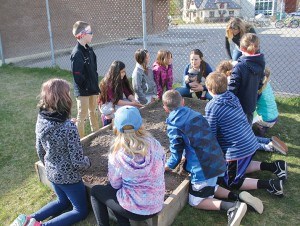Students from Jasper Elementary School (JES) werenÔÇÖt afraid to get a little dirty to learn about the benefits of locally grown food, May 18.
Marissa Kidd and Jamie Orfald-Clarke, members of the Jasper Local Food Society, spent the morning teaching students about gardening and where their food comes from.
ÔÇťThe goal is to get kids connected back to the Earth again and to one another,ÔÇŁ said Kidd.
Before rolling up their sleeves, Orfald-Clarke had children circle around him as he dissected a store-bought sandwich piece by piece to discuss where each part of the sandwich likely came from, such as the lettuce and the tomato.
Using a measuring tape as a teaching prop, the group talked about how many kilometres it would likely take to get each piece of the sandwich to Jasper. By the time they were done, the measuring tape was 85 inches in length representing the equivalent of 8,500 kilometres.
The students then talked about how they could make the same sandwich with ingredients grown closer to home, such as growing lettuce in their own gardens or buying tomatoes at the local farmersÔÇÖ market. In the end, the tape measure was significantly shorter, measuring approximately 15 inches or 1,500 km.
ÔÇťIn a place like Jasper, where most of the food comes from far away, itÔÇÖs a lot more difficult for them to connect to what it means to grow your own,ÔÇŁ said Kidd.
ÔÇťWe live in national park so thereÔÇÖs a different kind of idea that kids in Jasper grow up with about what our relationship with the environment is because itÔÇÖs very much hands off. So I think itÔÇÖs important for kids to connect to the Earth in a really hands on way to be able to eat the food that is grown in the park.ÔÇŁ
Following their short lesson about locally grown food, students got an opportunity to try their own hand at gardening by mixing manure, bone meal and ash into the soil.
Kidd also showed them how to properly plant their sunflower sprouts and taught students how some plants grow better together than with others before planting a few bean seeds themselves.
Earlier this year the Jasper Local Food Society with the help of the local shop class at the high school built and designed three garden plots located at JES.
ÔÇťMy understanding is when the school moved the gardens didnÔÇÖt move along with the school so the Local Food Society has partnered with the schools to revitalize the garden project that Jeanine DÔÇÖAntonio originally envisioned,ÔÇŁ said Kidd.
ÔÇťWe have one plot for each school, but the idea is that this will bring the schools together around a communal thing, which is food.ÔÇŁ
She said there is a lead class responsible for each garden to ensure itÔÇÖs properly watered and taken care of through the summer.
In addition to building relationships between the three schools, Kidd said the plants will also help to get the food societyÔÇÖs local seed library up and running.
Earlier this year the Jasper Local Food Society announced it was creating a seed library pilot project at the Jasper Municipal Library.
Not to be confused with a seed bank, which is designed to stockpile seeds in case of prolonged war or severe drought, a seed library is alive, allowing gardeners to borrow seeds, plant them and harvest the spoils before returning a fresh set of seeds at the end of the plantÔÇÖs cycle.
ÔÇťThe idea is the kids can plant it and eat all the food, but also learn about seed saving and be able to give back to the seed library on an ongoing basis,ÔÇŁ said Kidd.
For more information about the Jasper Local Food Society or the seed library, visit the non-profit groupÔÇÖs Facebook page.
Paul Clarke | [email protected]

